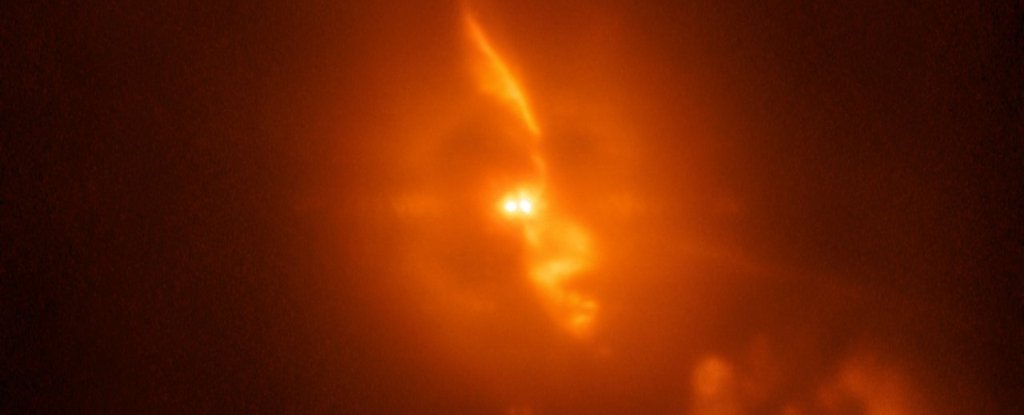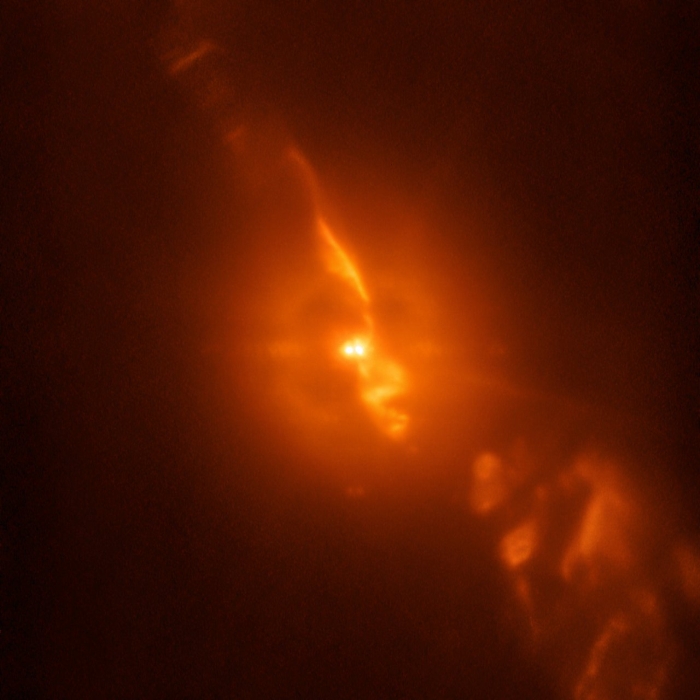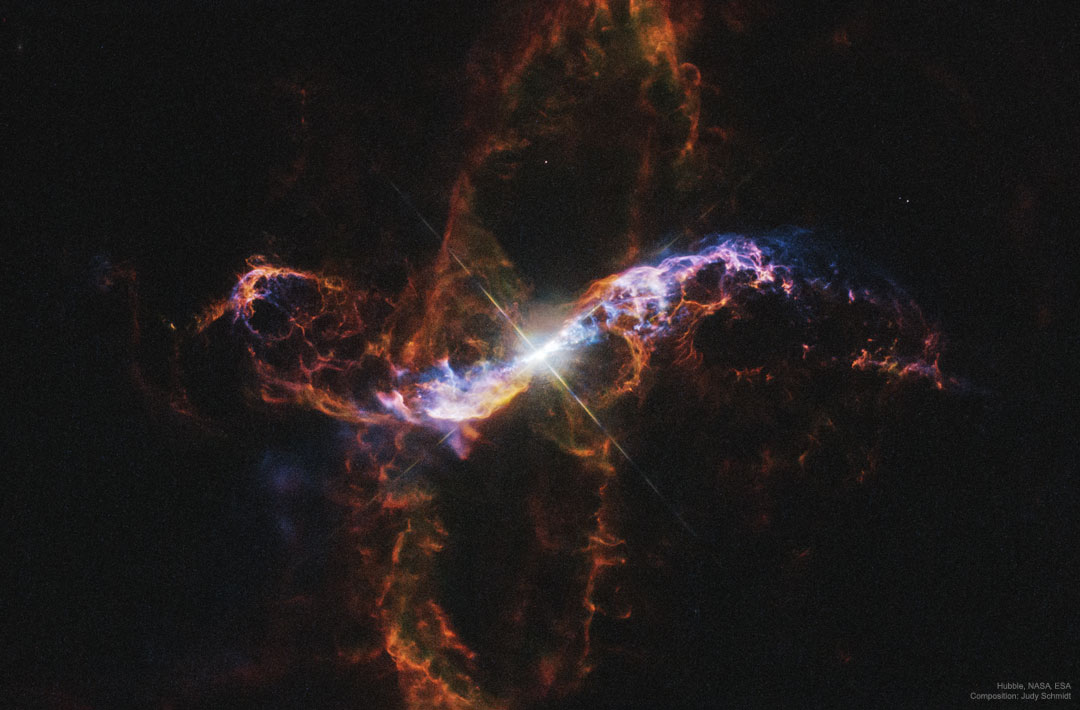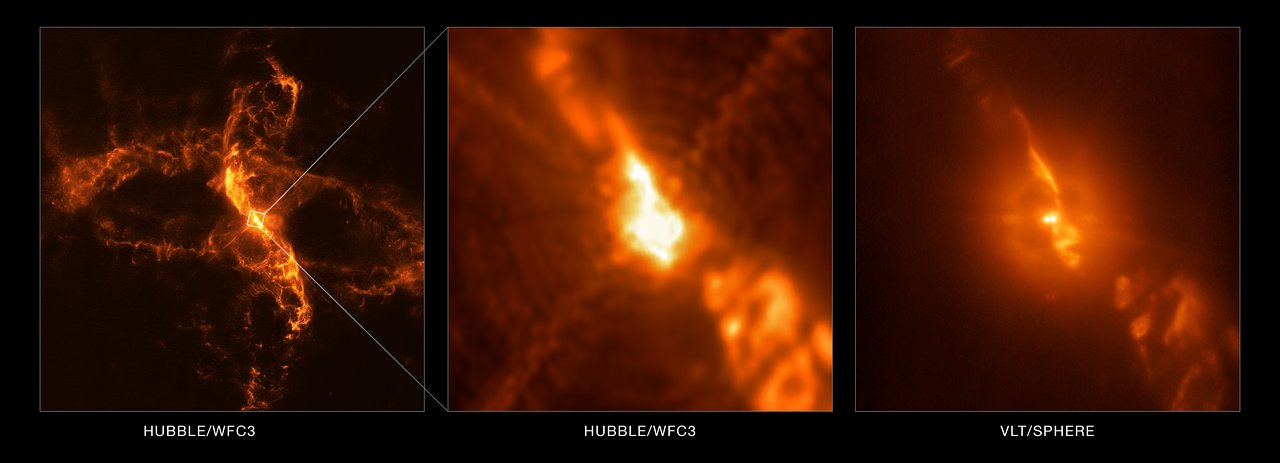Supernova
A supernova blast may have caused a mass extinction 359 million years ago.
This Breathtaking Image Is a Real Photo of Two Stars Destroying Each Other
The death of a binary star can be a spectacularly violent thing.
This picture shows the binary system R Aquarii, a red giant throwing off its outer envelope, which is being greedily cannibalised by its companion, a much smaller, denser white dwarf.

The dramatic moment you’re looking at unfolded just 650 light-years from Earth – practically right next door in astronomical terms, which is why astronomers have a keen interest in the event.
 (ESO/Schmid et al.)
(ESO/Schmid et al.)
But this new image of the interaction – taken in near-infrared by the SPHERE planet-hunting instrument on the European Southern Observatory’s Very Large Telescope – gives us an incredibly detailed new glimpse of the action.
For contrast, here is a picture taken by the Hubble Space Telescope of the nebula Cederblad 211 – the dust and gas cloud that the stars are in the process of creating.
 (Judy Schmidt; Hubble, NASA, ESA)
(Judy Schmidt; Hubble, NASA, ESA)
And another image taken by the Wide Field Camera 3’s near-infrared instrument.
 (ESO/Schmid et al./NASA/ESA)
(ESO/Schmid et al./NASA/ESA)
What’s happening here is very turbulent. The red giant is what is known as a Mira variable star, a star at the very end of its lifespan. These kind of stars have already lost at least half their material, and as they pulsate, they reach a brightness 1,000 times that of the Sun.
The white dwarf – an end-of-life star that has exhausted its nuclear fuel – is also quite busy. The material it devours from the red giant accumulates on the white dwarf’s surface, occasionally triggering an enormous thermonuclear explosion that blasts the material out into space.
This amazingly clear image shows both the stars at the centre of the jets of material spinning out into space. Eventually, this binary system’s life could end in a colossal explosion – a Type Ia supernova.
Did a Supernova Give Birth to Our Solar System?

The explosive death of a star — that may have been up to a dozen times the sun’s mass — might have triggered the formation of the solar system, a new study finds.
The sun as well as the rest of the solar system was born from a cloud of gas and dust about 4.6 billion years ago. According to previous research, some event disturbed this cloud, prompting a gravitational collapse that formed the sun and a surrounding disk of matter, where the planets were born.
By searching for telltale patterns that have been left in matter from the dawn of the solar system, Yong-Zhong Qian, co-author of the new study and an astrophysicist at the University of Minnesota in Minneapolis, and his colleagues now suggest that the explosive death of a small star could have kicked off that collapse. [Our Solar System: A Photo Tour of the Planets]
Prior work has suggested that a supernova’s shock wave might have packed enough energy to compress the preexisting cloud of dust. And researchers have searched for evidence of that blast: Supernovas generate telltale patterns of unstable, short-lived radioactive isotopes. The discovery of the signatures of such anomalies in ancient rocks would help confirm the idea that a supernova triggered the solar system’s formation. (The isotopes of an element have different numbers of neutrons. A different number at the end of the isotope’s name identifies each variety: for example, beryllium-9 or beryllium-10.) Until now, researchers have failed to find the fingerprints of these isotopic anomalies in ancient meteorites that were left over from the birth of the solar system. However, researchers had been examining supernovas from relatively high-mass stars — those that are 15 or more times the sun’s mass, Qian told Space.com. Qian’s group chose to model lower-mass supernovasinstead, from stars that are 12 times the sun’s mass or less, and they investigated what isotopes would be formed from those explosions. They focused on the production of beryllium-10, an isotope that is commonly found in meteorites. Its prevalence in meteorites was already a mystery for researchers, Qian said. One theory held that high-energy cosmic rays could have stripped away protons or neutrons from atomic nuclei to create the beryllium-10 — a process called spallation.
Using new supernova models, Qian and his colleagues found that a low-mass supernova could generate vast amounts of ghostly particles known as neutrinos, whose influence on atomic nuclei could have created beryllium-10 — which would explain the high levels of that isotope in the meteorite record.
Moreover, the researchers said that the influence of a low-mass supernova might also explain the presence of other short-lived isotopes that are also found in meteorites, such as calcium-41 and palladium-107. “A low-mass supernova can explain the wide range of data that we have,” Qian told Space.com.
Qian noted that the study group’s findings do not explain the presence of all short-lived isotopes that are found in meteorites. “We think that some of these other short-lived nuclei might have been contributed by other mechanisms,” Qian said. “I don’t think that should be taken as a weakness of our model — it’s just that our model cannot explain everything. Our work is a major piece of the puzzle about the solar system’s formation, but there are other pieces of the puzzle that should be looked at as well.”
This supernova exploded not once, but twice
Astronomers find a superluminous supernova that seems to have exploded twice.
Most supernovae explode only once, but a newly found superluminous star did something truly bizarre: it exploded twice.

A recently discovered class of supernovae called superluminous supernovae (SLSN) are brighter and longer-lasting. Only a dozen or so have been found, and using the Gran Telescopio CANARIAS (GTC), astronomers have found evidence of another, but reveals surprising behavior. It seems to have exploded not only once, but twice. The findings are published in The Astrophysical Journal Letters.
There are several different types of supernovae; the most well known type Ia, where a white dwarf star absorbs mass from another star or collides with another white dwarf which causes a thermonuclear explosion as its mass becomes unstable. The other types of supernovae are caused when massive stars use up all their fuel and can no longer fuse atoms together in its core. They then collapse under their own gravity causing a supernova.
The research has revealed that the supernova had an initial increase in brightness, declined for a few days, then increased again even stronger than before.
“Superluminous supernovas are up to a hundred times more energetic than type Ia supernovae because they can remain bright for up to six months before fading, rather than just a few weeks,” explains Mathew Smith, the lead author of the study and a postdoctoral researcher at the University of Southampton, in a press release. “What we have managed to observe, which is completely new, is that before the major explosion, there is a shorter, less luminous outburst, which we can pick out because it is followed by a dip in the light curve, and which lasts just a few days.”
This is the first time something like this has ever been observed in a supernova.
“From our data, we have tried to determine if this is a characteristic unique to this object, or whether it is a common feature of all superluminous supernovae, but has not been observed before, which is perfectly possible given their unpredictable nature,” Smith says.
Discovered on December 21, 2014, the object was given the name DES14X3taz by the Dark Energy Survey (DES) which studies the expansion of the universe through dark energy, but occasionally detects supernovae and other transient phenomenon.
As soon as DES14X3taz was found, the GTC made it a priority for two nights of observation on January 26 and February 6, 2015. The GTC is able to devote some of its time to these transient objects as they may offer unrepeatable opportunities.
The GTC has a 10.4 meters mirror that, when combined with its powerful spectroscopy instrument, make it the ideal tool to observe SLSNe. Using data from the GTC and other telescopes, Smith and his team were able to reconstruct the brightness of DES14X3taz almost from the moment of its detection. They have determined its absolute brightness with great precision and its distance of 6.4 billion light-years.
The researchers concluded, after comparing their observations to many models, that the most plausible explanation is the birth of a magnetar, or a neutron star rotating very rapidly on its axis. The initial peak, decline, then quick rise back to brightness is consistent with that of an emission of a huge bubble of material that cools as it grows.
“We think that a very massive star, some 200 times the mass of the Sun, collapses to form a magnetar. In the process, the first explosion occurs, which expels into space a quantity of matter equivalent to the mass of our sun, and this gives rise to the first peak of the graph,” says Smith to Phys.org. “The second peak occurs when the star collapses to form the magnetar, which is a very dense object rotating rapidly on its axis, and which heats up the matter expelled from the first explosion. This heating is what generates the second peak in the luminosity.”
Understanding this process may allow astronomers to “standardize” the model for SLSN as has already happened for type Ia supernovae. Its large luminosity makes these objects ideal candidates for calculating distances on larger scales and with greater accuracy than with current techniques. First is understanding their origin and their nature.
Until now, the only other examples of SLSNe have been in small galaxies with low metallicity (small amounts of heavy elements), which is still not well understood. Smith says, “it is a part of the mystery of these objects.” A huge priority to continue studying these objects is to detect more of the SLSNe and observe them from the moment they explode in real time with a telescope comparable in size to the GTC.
Hubble Captures Impressive Stellar Explosion.
This is a Hubble Space Telescope composite image of a supernova explosion designated SN 2014J in the galaxy M82. At a distance of approximately 11.5 million light-years from Earth it is the closest supernova of its type discovered in the past few decades. The explosion is categorized as a Type Ia supernova, which is theorized to be triggered in binary systems consisting of a white dwarf and another star — which could be a second white dwarf, a star like our sun, or a giant star.
Astronomers using a ground-based telescope discovered the explosion on January 21, 2014. This Hubble photograph was taken on January 31, as the supernova approached its peak brightness. The Hubble data are expected to help astronomers refine distance measurements to Type Ia supernovae. In addition, the observations could yield insights into what kind of stars were involved in the explosion. Hubble’s ultraviolet-light sensitivity will allow astronomers to probe the environment around the site of the supernova explosion and in the interstellar medium of the host galaxy.
Because of their consistent peak brightness, Type Ia supernovae are among the best tools to measure distances in the universe. They were fundamental to the 1998 discovery of the mysterious acceleration of the expanding universe. A hypothesized repulsive force, called dark energy, is thought to cause the acceleration.
The January 31 image, shown here as an inset, was taken in visible light with Hubble’s Wide Field Camera 3. This image was superimposed into a photo mosaic of the entire galaxy taken in 2006 taken with Hubble’s Advanced Camera for Surveys.
Among the other major NASA space-based observatories used in the M82 viewing campaign are Spitzer Space Telescope, Chandra X-ray Observatory, Nuclear Spectroscopic Telescope Array (NuSTAR), Fermi Gamma-ray Space Telescope, Swift Gamma Ray Burst Explorer, and the Stratospheric Observatory for Infrared Astronomy (SOFIA).

Early observations identify star at heart of nearby supernova.
Teams confirm that explosion started with a white dwarf.
A stellar explosion has helped astronomers to confirm the leading theory as to what causes type Ia supernovae. The explosion is the closest to the Solar System in the past 25 years, and was spotted a mere 11 hours after light from its eruption first reached Earth.
The favoured model suggests that a type Ia supernova is triggered when a white dwarf — an inactive star that crams roughly the mass of the Sun into the volume of the Earth — siphons material from a companion star. The extra mass triggers a thermonuclear explosion that blows the dwarf to smithereens.
Supernova SN 2011fe occurred in the Pinwheel galaxy, just 6.4 million parsecs (21 million light years) away from Earth. Analysing observations of the supernova made in August, a team of astronomers reports today in Nature1 that it has for the first time identified the type of star that exploded. Another team has narrowed down the probable nature of the companion star that triggered the eruption2.
Compact culprit
Researchers in the first team calculated the energy of the shock wave that ripped through the star, and learned that the original star could have been no bigger than about one-tenth the radius of the Sun1. It was dense and compact, strongly indicating a white dwarf, says Peter Nugent, an astronomer at the Lawrence Berkeley National Laboratory in Berkeley, California, and a co-author of both studies.
“Until now, white dwarfs were just theoretically implicated in type Ia supernovae,” adds Andy Howell, an astronomer at Las Cumbres Observatory Global Telescope Network in Goleta, California, who is also a co-author of both papers. “Now we’ve finally got the goods.”
The team’s observations also revealed the composition of the white dwarf. Early in the explosion, the researchers were able to record the light spectra of material from the lower-density, outermost layers of the star, including small bits that hadn’t burned at all. They found the fingerprints of carbon and, for the first time, oxygen, moving at high speed. Nugent and his colleagues conclude that the star that exploded was a white dwarf composed mostly of carbon and oxygen.
The team also concluded that the white dwarf’s companion was probably a star that still burns hydrogen at its core, as the Sun does, rather than a larger red giant. Had the expanding shock wave from the exploded star collided with a red giant, the explosion would have become much brighter than was observed.
No giants
Using independent methodology, Weidong Li, an astronomer at the University of California, Berkeley, and his colleagues also ruled out a red giant as the companion star2. Li and his collaborators analysed high-resolution images of the Pinwheel galaxy, taken by the Hubble Space Telescope before the star exploded. The Hubble pictures do not record a star in what would be the location of the supernova, thus eliminating the possibility that the companion star was a red giant, which would have been bright, bloated and therefore easily visible.
Stan Woosley, a theoretical astronomer at the University of California, Santa Cruz, notes that although the companion’s identity remains unknown, the findings seem to vindicate the standard model for type Ia supernovae — down to the type of white dwarf at the heart of the event. He adds that the companion can’t have been very small or faint, given that it must have been able to donate a sizable chunk of mass to the white dwarf.
The result carries a larger significance because observations of type Ia supernovae are commonly used as ‘standard candles’ to probe the expansion of the universe: this year’s Nobel Prize in Physics was awarded to the heads of two teams who used the explosions to discover that cosmic expansion is accelerating rather than slowing down (see ‘2011 Nobel Prize for Physics: supernovae and the accelerating universe‘). Nugent says that by helping to explain how the explosions come about, the latest papers could make type Ia supernovae even more useful as standard candels.
The SN 2011fe observations “will be powerful constraints when the detailed credible models finally emerge”, says Woosley. He also notes that observations of other type Ia supernovae will be needed to determine the level of diversity within the class and whether that diversity will limit how accurately astronomers can measure cosmic expansion based on supernova data.
To that end, a means for obtaining more and better supernovae observations could be less than a decade away. SN 2011fe was discovered by the Palomar Transient Factory in California, a group of robotic telescopes that scans the skies nightly and alerts astronomers if the brightness of a body has changed. Astronomers are hoping that by 2020, a similar but much larger robotic telescope, the Large Synoptic Survey Telescope, will be open for business. This 8.4-metre instrument will scan the entire visible sky every week and could be an important tool for discovering whether type Ia supernovae can have different compositions or types of companions.
“Given the state of computers and the plans for ever larger transient surveys, I expect we are going to learn a lot, possibly pretty soon,” says Woosley.
Source:Nature.
Supernova Surprise: How to Spot a Fallen Star

Attendees of a Royal Astronomical Society meeting in Wales this week are likely abuzz over a study presented yesterday that says there really was a bright star that appeared the day King Charles II was born in May 1630.
Dubbed the royal star, this legendary celestial guest was described as a star shining so bright that it was visible during the day with the naked eye.
“Never [had] any Starre appeared before at the birth of any (the Highest humane Hero) except our Saviour,” English writer Edward Matthew penned in a 1661 pamphlet.
Although most historians thought such stories were royal propaganda, new evidence suggests the “star” may have been a supernova called Cassiopeia A.
CassA was once a massive star that ended its life in a violent explosion. According to the new calculations, since light from the blast would have taken about 10,000 years to reach Earth, the supernova would have appeared right around Charles’s 17th-century birth.
Whether the royal story is true or not, it is possible for people on Earth to witness the light from emerging supernovae.
One of the most famous examples is SN 1572, also known as Tycho’s Remnant. The object is named for Danish astronomer Tycho Brahe, who was among many people to record seeing a new star rivaling Venus in brightness that suddenly appeared in the constellation Cassiopeia in 1572.
Not all supernovae will be close enough or powerful enough to be seen from Earth with the naked eye. But sometimes you can glimpse a new “star” in popular astronomical objects that are visible with backyard telescopes.
For instance …
Supernovae Happen: The 2005 Whirlpool “Star”
by Robert J. Vanderbei
The Whirlpool Galaxy, aka M51, is not far—3.5 degrees—from the end of the handle in the Big Dipper. It is a popular target for observers from April through July, when the Dipper is high in the night sky.
M51 is especially interesting because it is actually a pair of interacting galaxies. They are flying past each other (on a time scale of hundreds of millions of years) and their mutual gravitational attraction creates some interesting distortions.
In May 2005 I took a picture of the Whirlpool Galaxy. About month later, a star in the Whirlpool exploded into a supernova.
The explosion was first noticed by amateur astronomer Wolfgang Kloehr on an image he took of the galaxy on June 28, 2005, using an eight-inch reflector telescope.
Even though the galaxy is 31 million light-years away (and therefore the explosion actually took place 31 million years ago), the supernova was bright enough to be seen using fairly modest telescopes here on Earth.
When I heard about this relatively rare cosmic event, I waited with great anticipation for the next clear night. On July 10, 2005, I got my opportunity, and I took a second picture of the galaxy.
I used exactly the same equipment as before so that I could easily do a side-by-side comparison of the two pictures.
Shown here is the first picture of the Whirlpool I took in May (top) and the followup shot I made in July. Click to see full size.
Note that the July 10 picture is identical to the earlier picture—except for a new bright spot just off to the right, a bit from the core of the galaxy. This is supernova SN 2005cs.
At its brightest, the supernova appeared to us as bright as a magnitude 14 star.
When I took my second picture, we were nearing the end of the season for observing M51—the Whirlpool was low in the northwest at sunset. Over the following weeks it became harder to see/photograph because it was very low in the west after sunset.
By the time the Whirlpool moved back into prime position several months later, the supernova had faded from view. I was very lucky to get a picture of it.
The last time a supernova was observed in our home galaxy, the Milky Way, was in 1604.
On average, supernovae in the Milky Way should occur once every 50 years or so. We might have missed a few if they happened on the other side of the Milky Way but, regardless, we are long overdue for a supernova event in our sector of the galaxy.
Hopefully, the next one will occur sometime soon.
Robert J. Vanderbei is chair of the Operations Research and Financial Engineering department at Princeton University and co-author of the National Geographic book Sizing Up the Universe. Vanderbei has been an astrophotographer since 1999, and he regularly posts new images on his astro gallery website.
source: national geographic channel

